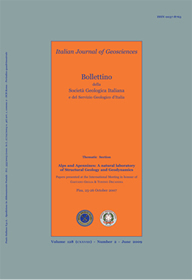
Plio-Quaternary tectonic evolution of the Northern Apennines thrust fronts (Bologna-Ferrara section, Italy): seismotectonic implications
G. Toscani(*), P. Burrato(**), D. Di Bucci(***), S. Seno(*) & G. Valensise(**)
(*) Dipartimento di Scienze della Terra, Università di Pavia. Via Ferrata, 1 - 27100 Pavia, Italy. E-mail: giovanni.toscani@unipv.it.
(**) Istituto Nazionale di Geofisica e Vulcanologia. Via di Vigna Murata, 605 - 00143 Roma, Italy.
(***) Dipartimento della Protezione Civile. Via Vitorchiano, 2 - 00189 Roma, Italy.
Volume: 128 (2009) f.2
Pages: 605-613
Abstract
The outermost, NE-verging fronts of the Northern Apennines (Italy) are overlain by a thick syntectonic sedimentary wedge filling up the basin beneath the Po Plain. Due to fast sedimentation rates and comparatively low tectonic rates, the fronts are generally buried. Evidence for their activity includes scattered historical and instrumental earthquakes and drainage anomalies controlled by growing buried anticlines. The largest earthquakes, up to Mw 5.8, are associated with active compression, with a GPS-documented shortening rate <1 mm/a.
We used geological, structural and morphotectonic data to draw a N-S-striking section between Bologna and Ferrara, aimed at analyzing whether and how the deformation is partitioned among the frontal thrusts of the Northern Apennines and identifying the potential sources of damaging earthquakes. We pointed out active anticlines based on the correspondence among drainage anomalies, historical seismicity and buried ramps. We also analyzed the evolution of the Plio-Quaternary deformation by modeling in a sandbox the geometry, kinematics and growth patterns of the thrust fronts.
Our results (i) confirm that some of the main Quaternary thrusts are still active and (ii) highlight the partitioning of deformation in the overlap zones. We note that the extent and location of some of the active thrusts are compatible with the location and size of the main historical earthquakes and discuss the hypothesis that they may correspond to their causative seismogenic faults.
Keywords
Get Full Text